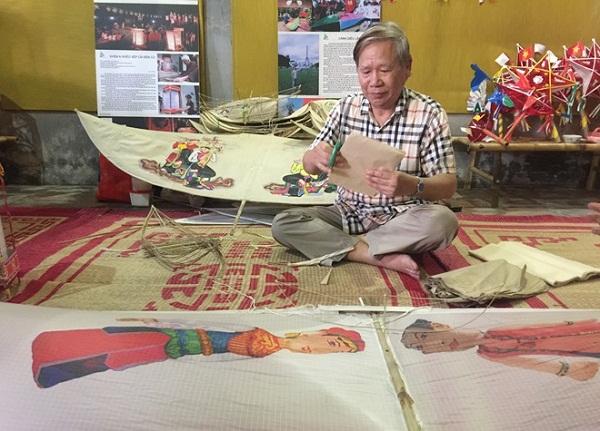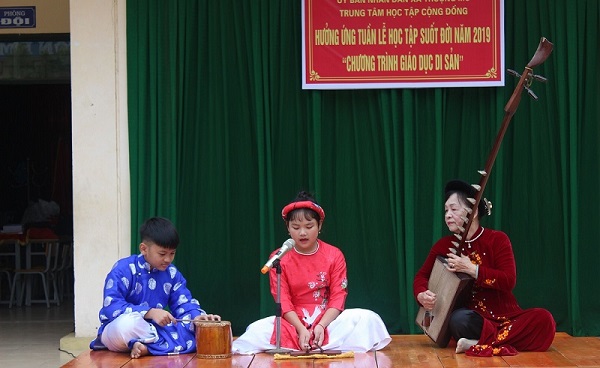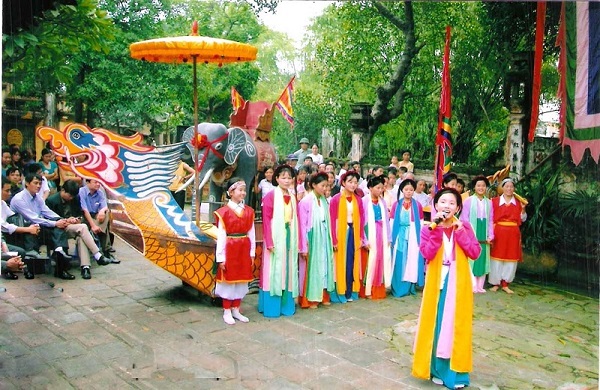Dan Phuong rural district, situated in the Northwestern region of Hanoi, is renowned for its rich cultural heritage. It has emerged as an enchanting destination for those seeking a rural cultural experience. The district is home to three significant intangible folk heritages, namely the kite flying festival in Ba Giang village, ca tru singing in Thuong Mo commune, and cheo tau (rowing singing) in Tan Hoi commune.
A Millennium-Old Kite Village by the Red River
| Craftsman Nguyen Huu Khiem, Head of Ba Duong Noi Kite Club. Photo: Thuy Linh/ VGP. |
The tradition of kite making and flying dates back over a thousand years in Ba Giang Village, also known as Ba Duong Noi village. Located in Hong Ha commune, Dan Phuong district, Hanoi, this village’s kite flying tradition originated from Nguyen Ca, a skilled general from the Dinh Dynasty (968-979). Legend has it that after retiring to his village, Nguyen Ca taught farming techniques and engaged in kite flying activities with the local children during his leisure time. Following his passing, a temple was constructed in his honor, and an annual kite festival was established to commemorate the general. Today, this kite festival, known as the largest in Northern Vietnam, attracts thousands of participants from across Vietnam and other countries every year on the fifteenth day of the third lunar month. Participants have the opportunity to witness a mesmerizing display of hundreds of flute kites, a distinctive feature of Ba Giang Village. These kites produce beautiful sounds as they soar in the sky, reflecting the skill and emotions of the kite players. The art of kite making and flying holds great significance for the people of Ba Giang, serving as a cherished cultural heritage passed down through generations. The Ba Giang Kite Club, comprising more than forty members, actively promotes and showcases this traditional art form, performing in various localities within Vietnam and abroad.
The Birthplace of the Queen of Ca Tru
| The Ca tru singing in Thuong Mo commune is transmited from generation to generation. Photo: Thuong Mo commune- Dan Phuong district. |
The village of Dai Phu in Thuong Mo Commune holds significant historical importance as the birthplace of ca tru in the region and the homeland of the Queen of this folk singing genre. Recognized by UNESCO as an intangible cultural heritage, ca tru is a complex form of poetry recital characterized by lyrics written in traditional Vietnamese poetic forms. Diverse variations of ca tru serve various social purposes, including worship, entertainment, court performances, and competitions. In the 17th century, a woman named Nguyen Thi Hong from the Nguyen Duy family in Dai Phu Village, highly regarded for her intelligence and poetic singing talent, particularly in ca tru, married King Le Hy Tong (1663-1718). Within the palace, she imparted training in ca tru singing to the king’s concubines and organized royal music events. Following her passing, the people of Thuong Mo built a temple in her honor, recognizing her as the Queen of ca tru. The Nguyen Duy family has diligently preserved the tradition of ca tru for generations. Today, Nguyen Thi Tam, a seventh-generation artisan from the family, remains dedicated to upholding the family’s legacy and nurturing a passion for ca tru. In 2004, she cofounded the Ca tru Club in Thuong Mo, where she imparts her knowledge to a new generation of ca tru enthusiasts, including renowned artists and young children. In recognition of her immense contribution to ca tru, she was nominated by the city of Hanoi to be bestowed the title of People’s Artist.
The Unique Art of Cheo Tau (Rowing Singing)
| The performance of cheo tau in Tan Hoi commune- Dan Phuong district. Photo: Nguoihanoi.com. |
Tan Hoi commune is renowned for its exceptional folk singing genre called cheo tau, unique to the area. This art form involves the performance of wooden “two dragon shape boats,” symbolizing the local heroes who fought against invaders. Each boat consists of 13 “rowers,” including a “captain” leading a choir of “sailors” numbering between 13 to 16. Accompanying each boat are elephant statues representing famous ancestral battles. These statues are controlled by disguised women, dressed as men. Notably, all the performers in cheo tau are women, lending further distinction to this art form. The performance encompasses various elements, such as individual singing, duets, and responsive singing between the two boats. Since its restoration in 1998, the cheo tau festival has been held annually, marking a robust revival and development of this captivating art form. Dedicated artists have dedicated themselves to preserving traditional folk songs and imparting their knowledge to younger generations. These individuals play a pivotal role in the establishment, sustainability, and growth of the Tan Hoi Cheo Tau Club, which has actively operated for 20 years.






